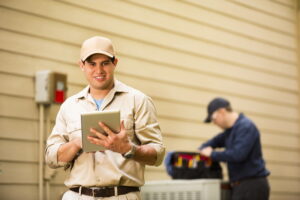The best thing about a heat pump is its versatility. It’s not just an air conditioner. It can also keep your home cozy all winter! But if it gets stuck in a single mode, that versatility is lost.
And most of the year, in Alabama, a heat pump stuck in heating mode is a huge problem. If your heat pump keeps trying to heat your home and can’t switch to cooling, we can tell you exactly why and what can be done about it.
How Heat Pumps Work
Just like an air conditioner, heat pumps function by using a compressor to pressurize refrigerant and keep it flowing through coils, soaking up heat from one location and then allowing it to dissipate in another. Unlike an air conditioner, the direction of a heat pump’s refrigerant flow is reversible.
In cooling mode, the compressor sends the refrigerant inward first, where it soaks up heat from your home before heading outside to release it. In heating mode, the compressor sends the refrigerant outward first, to absorb warmth from the outdoor air—which it can do even at very chilly temperatures, because the outdoor air doesn’t have to be warmer than the indoor air, it just has to be warmer than the super-cooled refrigerant.
How Refrigerant Flow Is Reversed
A heat pump has a component that air conditioners do not have. It’s called a reversing valve. It’s a small section of tube with three openings leading to refrigerant lines. It might remind you a bit of the portion of a trumpet that has three valves.
Inside the tube is a slider. In one position, it covers the first two openings, making a loop for the refrigerant to flow within them. When it slides over, it covers the second and third openings and the refrigerant flows within that loop. The sliding action is caused by pressure, and that pressure is applied by a solenoid, a type of electromagnet.
How Heat Pumps Get Stuck in Heating Mode
When an electric charge passes through the solenoid, it is activated, and the slider moves into the position necessary for cooling mode. When there is no electric charge, the solenoid is inactive, the slider is in the position necessary for heating mode.
This means that if anything prevents that electric charge from creating pressure on the slider, the heat pump will remain in heating mode. Three things can go wrong that would cause this.
- First, the thermostat could fail to send the appropriate signal.
- Second, a problem with the wiring between the thermostat and the solenoid could mean the signal is being sent but never received.
- Third, the solenoid itself can deteriorate from corrosion, heat, or general wear and tear.
Whichever one of these things has gone wrong, you need heat pump repair in Jefferson County, AL. A qualified, professional heat pump technician can test each of these components to determine exactly where the problem lies.
The thermostat can be recalibrated or repaired, the wiring can be redone, or the solenoid can be replaced. The system may seem complex overall, but these are straightforward repairs, and then you can get back to cooling your home to your heart’s content.
“Your experience is what matters most!” Contact Douglas Cooling & Heating today for help with all your heating and cooling needs.



